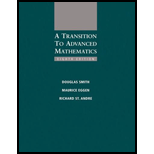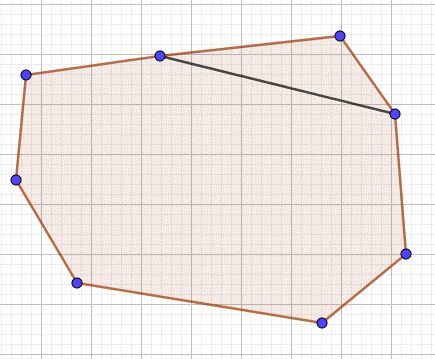
a.
Prove this by using generalized PMI and show that the equation or inequality is false.
a.
Explanation of Solution
Given :
It is given in the question that
Concept Used:
In this we have to use the concept of sets,induction and PMI.
Proof:
Assume there is a natural number
Then,
By the PMI,
Example for when the inequality y is false:
For
b.
Prove this by using generalized PMI and show that the equation or inequality is false .
b.
Explanation of Solution
Given :
It is given in the question that
Concept Used:
In this we have to use the concept of sets,induction and PMI.
Proof:
Assume there is a natural number
Then,
By the PMI,
Example for when the inequality is false:
For
c.
Prove this by using generalized PMI and show that the equation or inequality is false .
c.
Explanation of Solution
Given :
It is given in the question that
Concept Used:
In this we have to use the concept of sets,induction and PMI.
Proof:
Assume there is a natural number
Then,
By the PMI,
Example for when the inequality is false:
For
d.
Prove this by using generalized PMI and show that the equation or inequality is false.
d.
Explanation of Solution
Given :
It is given in the question that
Concept Used:
In this we have to use the concept of sets,induction and PMI.
Proof:
Assume there is a natural number
Then,
By the PMI,
Example for when the inequality is false:
Foe
e.
Prove this by using generalized PMI and show that the equation or inequality is false .
e.
Explanation of Solution
Given :
It is given in the question that
Concept Used:
In this we have to use the concept of sets,induction and PMI.
Proof:
Assume there is a natural number
Then,
By the PMI,
Example for when the inequality y is false:
For
f.
Prove this by using generalized PMI and show that the equation or inequality is false .
If x > 1 is a real number,then
f.
Explanation of Solution
Given :
It is given in the question that If x > 1 is a real number,then
Concept Used:
In this we have to use the concept of sets,induction and PMI.
Proof:
Let x be an arbitrary real number greater than
Assume there is a natural number
Then,
By the PMI,
Since x was arbitrary
Example for when the inequality is false:
For
g.
Prove this by using generalized PMI and show that the equation or inequality is false .
g.
Explanation of Solution
Given :
It is given in the question that
Concept Used:
In this we have to use the concept of sets,induction and PMI.
Proof:
Assume there is a natural number
Then,
By the PMI,
Example for when the inequality y is false:
For
h.
Prove this by using generalized PMI and show that the equation or inequality is false .
h.
Explanation of Solution
Given :
It is given in the question that
Concept Used:
In this we have to use the concept of sets,induction and PMI.
Proof:
Assume there is a natural number
Then,
By the PMI,
Example for when the inequality is false:
For
i.
Prove this by using generalized PMI and show that the equation or inequality is false .
For all
i.
Explanation of Solution
Given:
It is given in the question that ifall
Concept Used:
In this we have to use the concept of sets,induction and PMI.
Proof:
The sum of the interior angles of a triangle is 180°.
Assume there is a natural number
The sum of the interior angles of a polygon of
By the PMI,the prove is done.
Example for when the inequality is false:
For

j.
Prove this by using generalized PMI and show that the equation or inequality is false .
j.
Explanation of Solution
Given :
It is given in the question that
Concept Used:
In this we have to use the concept of sets,induction and PMI.
Proof:
Assume there is a natural number
Then,
By the PMI,
Example for when the inequality is false:
For
Want to see more full solutions like this?
Chapter 2 Solutions
A Transition to Advanced Mathematics
- 4. Find the general solution and the definite solution for the following differential equations: (a) +10y=15, y(0) = 0; (b) 2 + 4y = 6, y(0) =arrow_forward5. Find the solution to each of the following by using an appropriate formula developed in the lecture slides: (a) + 3y = 2, y(0) = 4; (b) dy - 7y = 7, y(0) = 7; (c) 3d+6y= 5, y(0) = 0arrow_forward1. Evaluate the following improper integrals: (a) fe-rt dt; (b) fert dt; (c) fi da dxarrow_forward
- 8. Given the rate of net investment I(t) = 9t¹/2, find the level of capital formation in (i) 16 years and (ii) between the 4th and the 8th years.arrow_forward9. If the marginal revenue function of a firm in the production of output is MR = 40 - 10q² where q is the level of output, and total revenue is 120 at 3 units of output, find the total revenue function. [Hints: TR = √ MRdq]arrow_forward6. Solve the following first-order linear differential equations; if an initial condition is given, definitize the arbitrary constant: (a) 2 + 12y + 2et = 0, y(0) = /; (b) dy+y=tarrow_forward
- 4. Let A = {a, b, c, d, e, f}, B = {e, f, g, h} and C = {a, e, h,i}. Let U = {a, b, c, d, e, f, g, h, i, j, k}. • Draw a Venn Diagram to describe the relationships between these sets Find (AB) NC • Find (AC) UB Find AUBUC • Find (BC) N (A - C)arrow_forward7. A consumer lives on an island where she produces two goods x and y according to the production possibility frontier x² + y² < 200 and she consumes all the goods. Her utility function is U(x, y) = x y³. She faces an environmental constraint on her total output of both goods. The environmental constraint is given by x + y ≤20. • (a) Write down the consumer's optimization problem. (b) Write out the Kuhn-Tucker first order conditions. (c) Find the consumer's optimal consumption bundle (x*, y*).arrow_forward3. Answer the following questions: (a) Given the marginal propensity to import M'(Y) = 0.1 and the information that M = 20 when Y = 0, find the import function M(Y). (b) Given a continuous income stream at the constant rate of $1,000 per year, what will be the present value II if the income stream terminates after exactly 3 years and the discount rate is 0.04? (c) What is the present value of a perpetual cash flow of $2,460 per year, discounted at r = 8%?arrow_forward
- 5. Let A and B be arbitrary sets. Prove AnB = AUB.arrow_forward2. Answer the following questions: (a) Given the marginal-revenue function R'(Q) = 28Q - €0.3Q, find the total-revenue function R(Q). What initial condition can you introduce to definitize the constant of integration? = (b) Given the marginal propensity to consume C'(Y) 0.80.1Y-1/2 and the information that C = Y when Y = 100, find the consumption function C(Y).arrow_forward7. Let X, A, and B be arbitrary sets such that ACX and BC X. Prove AUB CX.arrow_forward
 Algebra for College StudentsAlgebraISBN:9781285195780Author:Jerome E. Kaufmann, Karen L. SchwittersPublisher:Cengage LearningAlgebra & Trigonometry with Analytic GeometryAlgebraISBN:9781133382119Author:SwokowskiPublisher:Cengage
Algebra for College StudentsAlgebraISBN:9781285195780Author:Jerome E. Kaufmann, Karen L. SchwittersPublisher:Cengage LearningAlgebra & Trigonometry with Analytic GeometryAlgebraISBN:9781133382119Author:SwokowskiPublisher:Cengage Elements Of Modern AlgebraAlgebraISBN:9781285463230Author:Gilbert, Linda, JimmiePublisher:Cengage Learning,
Elements Of Modern AlgebraAlgebraISBN:9781285463230Author:Gilbert, Linda, JimmiePublisher:Cengage Learning,
 College AlgebraAlgebraISBN:9781305115545Author:James Stewart, Lothar Redlin, Saleem WatsonPublisher:Cengage Learning
College AlgebraAlgebraISBN:9781305115545Author:James Stewart, Lothar Redlin, Saleem WatsonPublisher:Cengage Learning Mathematics For Machine TechnologyAdvanced MathISBN:9781337798310Author:Peterson, John.Publisher:Cengage Learning,
Mathematics For Machine TechnologyAdvanced MathISBN:9781337798310Author:Peterson, John.Publisher:Cengage Learning,





